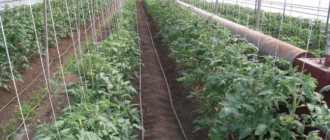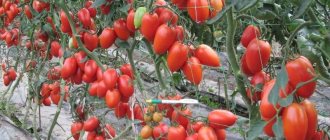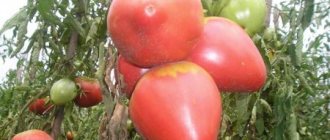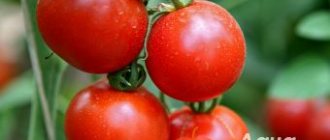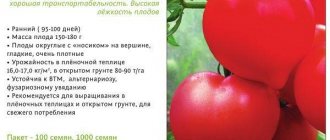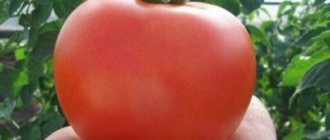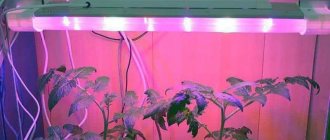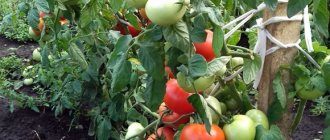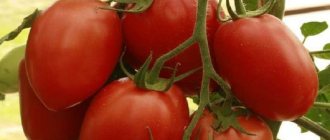Tomato Anastasia is one of the universal varieties that gardeners prefer for planting on their plots. Its amazing characteristics make it possible to obtain high yields in different climatic conditions. This is a hybrid tomato of a universal growing type. Brought out by Russian scientists in 1998 and registered by the State Register as a crop for open ground, greenhouses and film shelters.
Excellent external and taste characteristics brought the variety to one of the first places in the popularity ranking
Description of the variety
Variety Anastasia is a type of hybrid. Appeared as a result of crossing different varieties. Has good frost resistance. Ripens within 105-110 days from the moment the seedlings are planted in the ground.
Bushes are limited in growth and determinant. The height of one in open conditions reaches an average of 110 cm. In a greenhouse, the bushes grow up to 130 cm. Anastasia is also grown under film.
Not to be confused with namesakes
The Anastasia variety has several namesakes. Do not under any circumstances confuse Anastasia and the Nastenka variety. Nastenka is also a hybrid, but only an early ripening one, ripens within 80 days. The Nastenka variety is a determinate bush, the maximum height of which is 60 cm. The tomatoes are large, red, the weight of one is about 200 g.
There is another variety called Nastya-Slastena. The hybrid is famous for its tasty fruits and ease of care. The ripening period is early, the first harvest is obtained after 90 days. The height of the bushes is about 110 cm, but in a greenhouse it reaches more. Gardeners harvest about 2.5 kg of tomatoes from one Nastya-Slastena bush.
Important! The main difference between varieties is the ripening time.
Distinctive features
Anastasia matures quickly and can handle long-distance transportation without problems. Thanks to this, tomatoes are often grown not only for personal consumption, but also for sale.
The growth and development of plants is practically not affected by soil fertility: an excellent harvest is obtained even in soils with a small amount of nutrients. The hybrid must be tied to supports and excess shoots must be periodically removed.
Characteristics of tomatoes, yield
Tomatoes are green at maturity and then gradually acquire a rich red color. The weight of one tomato is from 130 to 180 g. The shape is round, the peel is dense and glossy. The pulp is juicy and soft. The fruits of the Anastasia variety do not crack and have a good shelf life.
Productivity is high. Subject to all growing rules, from 1 sq. m, gardeners harvest about 20 kg of ripe and tasty tomatoes.
Video
HARVEST TOMATO SHUTTLE! I RECOMMEND FOR BEGINNERS TO BUSY GARDENERS. Olga Chernova.
THREE very productive varieties of tomatoes - review!
The best varieties of pink tomatoes!
Review of the most popular varieties of tomatoes grown here!
TOMATOES FOR THE LAZY! This variety does not get sick and does not require pinching or gartering.
LEADERS AMONG TOMATOES! 7 BEST CHERRY TOMATOES
THE MOST PRODUCTIVE VARIETIES OF TOMATOES (BEST VARIETIES OF TOMATOES)
Tomato Nastenka (best productive tomato varieties)
Review of tomatoes 2022. Varieties Ozharovsky Pink, Banana Legs, Anastasia Ushakova and others.
THE BEST VARIETY OF LOW GROWING TOMATOES!
I still collect these tomatoes! The best tomato varieties and hybrids of the 2020 season
10 BEST LOW GROWING VARIETIES OF TOMATOES FOR OPEN GROUND. According to reviews from gardeners
Tomato Mongolian Dwarf: the productivity of this variety is legendary!
The most productive tomato varieties? The best varieties of tomatoes? Verified
THE BEST VARIETIES OF TOMATOES, DESCRIPTION OF TOMATO VARIETIES IN OUR GREENHOUSE. GARDEN AND GREENHOUSE
THIS IS A TOMATO!!!ULTRA EARLY,SUPER PRODUCTIVE TOMATO LYUBASHA!BEST TOMATOES!
YOU JUST HAVE TO PLANT THIS TOMATO ON YOUR LAND! TOMATO NEW JACK POT
Tomato "Jack Pot" | golden seed
How do you like the article?
Ivanova Tatyana
Ask a Question
How to grow seedlings
Seedlings are prepared at the end of March or beginning of April. Before this, you need to prepare the seeds, soil and growing container.
Seed preparation
Hybrid seeds can be purchased in a store or ordered by mail.
As a rule, the bags contain all the information about the manufacturer and planting recommendations. Trust only trusted suppliers. To be on the safe side, consult your garden neighbors and find out which supplier is best to purchase seed from. Next you need to carry out disinfection. To do this, use hydrogen peroxide. Although purchased seeds are already pre-treated, disinfection will not be superfluous. Soak the seeds in damp gauze or cotton pad. This will increase the immunity of the material and create favorable conditions for growing in the future.
Container and soil
Containers for seedlings are sold in the store.
These are special containers for seedlings, cassettes or flower pots. You can save money and plant seeds in ordinary wooden boxes or plastic jars. The main thing is to wash them and dry them first. The situation is similar with soil. Some prepare the soil themselves . To do this, you will need a mixture of soil, peat, humus, ash and sand in a ratio of 4:1:1:1:1. Mix all the elements and disinfect with a manganese solution. Water the soil with warm water and once dry, begin planting the seeds.
In order not to waste time and effort, some gardeners purchase a ready-made mixture for seedlings. It already contains all the necessary vitamins and minerals; it does not need to be further disinfected.
An excellent option is “Krepysh” soil. Purchase such material at any specialized gardening store.
Sowing
When the seeds and soil are ready, start sowing. Pour soil into a container, make small holes about 1 cm deep in it. Place the seed in them and sprinkle soil on top. Next, pour in plenty of warm water.
To create the best conditions, cover the seedlings with film or glass. This will create the desired microclimate. Remove the film little by little over two weeks. This way the sprouts will get used to the air temperature and humidity level.
Growing and care
Seedlings should be grown in a warm and bright place. Without the right amount of light, the stems develop very slowly. Use growth stimulants - they will give the plant additional strength.
Water the seedlings very carefully. Do not allow the soil to dry out or become waterlogged. It is better to spray the sprouts with a small amount of water, otherwise late blight or signs of rotting will appear on them in the future. The ideal temperature for growing is about 20 degrees.
Growing rules
The agricultural technology of the Nastena-slastena tomato, according to reviews from those who have been involved in the crop for a single year, is practically no different from other varieties:
- growing seedlings;
- landing in a permanent place;
- watering and weeding;
- loosening the soil and mulching;
- feeding and protection from diseases.
Planting seedlings
Tomatoes of the Nastya-slastena variety are best grown in seedlings, despite the early ripeness of the plant.
Sowing is scheduled for mid-March or early April. It all depends on the climatic conditions of the region. You just need to count 60 days from the intended planting of seedlings in a permanent place.
Preparing containers and soil
You can plant seeds in different ways:
- into containers;
- into the snail;
- in peat pots or tablets.
You can take ready-made soil or prepare it yourself. You need to take equal parts of ordinary soil and humus, add sand and wood ash.
Before sowing tomato seeds, the container and soil are spilled with boiling water, adding several crystals of potassium permanganate to it. This is a necessary measure for the prevention of fungal diseases and the destruction of pests.
Sowing seeds and caring for seedlings
Before planting, seeds are soaked for 30 minutes in a pink solution of potassium permanganate or in any growth stimulant in accordance with the instructions.
The seed is buried 1 cm. The distance between the furrows is 3 cm. The soil is moistened, the container is covered with film and placed on a lighted window. The best temperature for seed germination is 22-24 degrees. When the first shoots appear, the film is removed.
Further care for Nastya-slastena tomato seedlings comes down to watering and superficial loosening of the soil. You can feed the plants with a solution of wood ash.
Comment! Under no circumstances should excessive watering be allowed, as this may cause damage to the root system by blackleg.
Dive
Transplanting tomatoes is a necessary condition for obtaining plants with a powerful stem and a well-developed root system.
When the 3rd leaf appears on the Nastena-slastena tomato, it’s time to pick. It is advisable to use the same soil as when sowing seeds. The seedlings are watered and selected with a clod of earth. Make a hole in the pot and place the seedling up to the cotyledon leaf. After transplanting, water the soil with warm water.
2 weeks before planting in a permanent place, seedlings of the Nastya-slastena variety are hardened off. They are taken outside and gradually accustomed to new conditions. As a rule, at the time of planting, the bushes have the first cluster of green fruits.
Transfer
If the greenhouse is heated, Nastya the Sweet Tomato seedlings can be transplanted into it in mid-May. As usual - in early May. These terms are approximate, since they depend on the climate zone in which the gardener lives.
Seedlings can be planted in open ground after a stable positive temperature has been established. And, most importantly, the morning frosts will not return.
Planting pattern for tomatoes Nastya-slastena 30x50 cm in a checkerboard pattern.
Landing rules
The holes are prepared 14 days before planting so that the soil has time to settle. You need to add humus to each hole and pour it well with hot water and potassium permanganate.
Attention! Nastya does not recommend fresh manure for fertilizing tomato seedlings, as it promotes the growth of green mass. The seedlings are watered to make it easier to remove from the cup
Plant in the center of the hole, compact the soil and water
The seedlings are watered to make it easier to remove from the cup. Plant in the center of the hole, compact the soil and water.
Important! The leaves under the first brush need to be torn off to speed up the establishment of seedlings
Aftercare
The formation of Nastya-sweetness hybrid bushes is carried out after 2 weeks, when the plants take root. The best harvest is obtained on bushes grown in 2 or 3 stems. Stepchildren must be removed throughout the growing season.
The description says that the Slastena tomato is a tall plant, so you will have to take care of tying it up. To do this, immediately after planting, install long stakes or stretch a trellis. It is necessary to tie not only the stems, but also the brushes themselves, as they can break off under the weight of the fruit. The first time they grab the stem at a level of 20-30 cm.
All other activities are the same as for other tomatoes: watering, loosening, removing weeds, mulching and fertilizing.
To feed the bushes, you can use an infusion of mullein, chicken droppings, and green grass. Wood ash is sprinkled under each bush as a top dressing and prevention against diseases. It is useful to sprinkle the leaves with this substance.
You shouldn’t forget about foliar feeding either. The Nastena sweet variety responds well to boric acid and iodine. This is not just additional nutrition. The plants' immunity is strengthened, the fruits fill and ripen faster.
How to grow tomatoes
After the seedlings have sprouted, proceed to the stage of transplanting the plants into the ground.
Landing
Prepare the beds before planting.
They must be clean, free of foreign debris and other plants. It is recommended to dig up the soil in the fall and loosen it in the spring. Also make sure that the soil does not contain remnants of previous diseases. A week before planting, it is recommended to add mineral and organic fertilizers to the soil. For example, add sand and peat, and then level the soil with a rake. For disinfection, it is recommended to water the beds with hot water.
As soon as the beds are ready, proceed to transplanting the sprouts. The holes should be located at a distance of about 40-60 cm from each other. Place the sprouts in them with lumps of the old soil on the roots. When you plant the bed, water the soil with warm water. Make sure that water does not get on the leaves. It is better to plant tomatoes in the morning or evening.
Important! The final stage of planting is the installation of pegs that will serve as support for the bushes. The height of each must be at least 1 m.
Care
It is necessary to water the bushes every 5-6 days. Pay attention to weather conditions as well. If it rains frequently, reduce the amount of water. If it's a hot and dry summer, increase it. The main thing is to remember that excess moisture leads to cracking of the fruit and the development of many diseases.
Important! The Anastasia variety is not protected from the formation of stepsons. Remove shoots carefully so as not to damage the remaining stems. Some gardeners recommend doing this with gloves.
Remove weeds periodically.
To create the best conditions, cover the beds with dry leaves. Also, do not forget to loosen the soil every 7-10 days. As soon as the fruit begins to set, tie the stems to the stakes. Otherwise, the branches will break under the weight of the vegetables. Don't forget about applying fertilizers. The first feeding is carried out 10 days after planting. The hybrid responds well to fertilizing based on ammonium nitrate, potassium salt, and other nitrogen-containing substances. Ordinary organic compounds, such as humus and liquid mullein, perform well as fertilizers.
Features of cultivation and possible difficulties
It is also necessary to tie up the Anastasia variety so that insects do not feast on fruits that come into contact with the ground. In addition, the garter provides the tomatoes with air ventilation between the bushes and convenient watering of the plants.
In addition to pegs for garter, you will need ribbons. It is best to use synthetic material, as it does not rot, which means it attracts less insects. It is better not to use ropes and wire for garters.
If Anastasia's leaves become dry and turn yellow, it means the plant lacks magnesium. A solution of Epsom salts or magnesium nitrate will help correct the situation. If the leaves have a pinkish tint, the bushes do not have enough sulfur. Replenish its deficiency with magnesium sulfate.
Diseases and pests
Among insects, the hybrid is most often attacked by wireworms. It penetrates the root system and destroys the roots of the bush, eating them. As a result, the bush dies, and the wireworm moves to another plant. There is also another pest called whitefly. This small insect looks similar to a white moth. The whitefly attacks the tomato in a flock, sits on the leaves and feeds on them. Spraying with whey or garlic solution helps get rid of pests.
Of the diseases, the worst enemy of all tomatoes, late blight, deserves special attention. It appears as brown spots on the leaves, which are very difficult to get rid of. The hybrid can also get blackleg. This fungus appears as a result of soil contamination and penetrates the weakest stems. To prevent it, it is recommended to monitor the light and watering regime and loosen the soil.
Pest and disease control
Despite the good immunity of the Anastasia hybrid, gardeners should pay attention to compliance with the requirements of agricultural technology and preventive treatments of plants. A tomato bush gets sick when it is weakened or unprotected. To prevent infection from occurring, you need to promptly:
- regulate the frequency and abundance of watering;
- control the level of air and soil humidity in the greenhouse;
- mulch the beds;
- inspect the plants.
Most often, symptoms of VTB or late blight appear on tomatoes of the Anastasia variety. At the first signs of the disease, you need to use saltpeter, Bordeaux mixture, copper sulfate, Topaz, and immediately remove infected plants.
Among the pests, slugs (ash will help), melon aphids (preparation “Zubr”), and whiteflies (“Confidor”) are considered dangerous.
The nuances of growing in open ground and in a greenhouse
Regardless of the growing conditions, it is worth disinfecting the soil in advance.
And in the greenhouse, additionally disinfect all hard surfaces. Attention is paid even to the pegs and garters. It is better to prepare new material every year, as traces of infections may remain on last year’s pegs. The hybrid gives a good harvest in open ground, so do not forget about fertilizers and fertilizing. The best helpers for this are calcium nitrate and eggshells, humus, urea and manure.
It is recommended to fertilize every 10-15 days. At the same time, study the appearance of the bushes. Pay attention to the color and shape of the leaves - this will help you understand what exactly the tomatoes are missing.
Growing rules
The agricultural technology for growing tomatoes of the Nastenka variety is quite simple and traditional for determinate plants. However, despite a number of advantages, there are also disadvantages. When growing seedlings, a gardener must have certain skills, while beginners must be prepared for difficulties. It is necessary to clearly know and adhere to the rules of planting seedlings, transplanting tomatoes, as well as further caring for them.
Planting seedlings
Nastenka tomatoes are recommended to be grown in seedlings even in the Southern regions. The production of seedlings begins at the end of February or early March, sowing seeds in shallow containers filled with purchased ready-made soil, pre-treated and filled with the necessary elements. It is better to purchase seeds for sowing in specialized stores that sell them in processed form.
When using garden soil:
- It is necessary to disinfect it by heating or a solution of potassium permanganate.
- Before planting, the soil is watered and compacted a little.
- The seed placement depth is no more than 1 cm.
- Before germination, the container is covered with glass or film to retain moisture. It is kept at temperatures up to 25 ºС.
- With the emergence of seedlings, the shelter is removed, and the temperature is lowered for a week to 14 - 16 ºС so that the seedlings do not stretch out. Subsequently, the temperature is maintained at 20 – 22 ºС.
- Watering is carried out as the soil dries with warm water.
- Seedlings dive when 1-2 true leaves appear in separate seedling pots, cups or other containers with a volume of at least 8x8 cm.
To get strong, healthy seedlings, you need sufficient lighting for 15-16 hours, regular watering without waterlogging and lowering the air temperature at night.
Tomato transplant
At the age of 60-65 days, Nastenka tomato seedlings are planted in a permanent place in open ground or a greenhouse. By this time, the tomato seedling should have 6-8 true leaves and at least one flower cluster. Planting dates directly depend on the type of shelter, weather conditions of the region and last from early April to June.
Plants are planted less often in greenhouses than in open ground. On average, per 1 m² of protected soil, the consumption of seedlings is 3 plants, open - 4. Plants are planted at a distance of 40-45 cm from each other with row spacing of 60-70 cm.
Warning! With a higher planting density of tomatoes, lighting and ventilation deteriorate, which contributes to the development of diseases and reduced fruit set.
Tomatoes are planted in open ground in sunny, protected from the north wind, non-flooded areas with fertile soil of a loose structure. Best predecessors:
- beans;
- peas;
- cabbage;
- corn;
- forage grasses.
Re-growing tomatoes after nightshade crops, peppers, and eggplants is not allowed due to the risk of spreading specific diseases.
The holes are dug in such a way that the tomato seedlings fit in them to the full height of the root ball without damaging it, and a depression is formed for watering. Plant watered seedlings in well-moistened holes.
Attention! To reduce transplant stress, use growth stimulants in accordance with the manufacturer's recommendations. And to improve fertilization of ovaries - spraying with boron solution
Growing the Nastenka variety involves the same agrotechnical measures as when caring for other determinate tomatoes. Regular watering, which is carried out depending on the condition of the soil 1-2 times a week to the entire depth of the root system, has a positive effect on yield growth.
For the first feeding, use a solution of mullein or complex fertilizers with nitrogen, for the next - with a predominance of phosphorus and potassium. Fertilizing is combined with watering to prevent excess moisture. Mulching with sawdust and straw helps conserve moisture and protect row spaces from weeds, but this creates problems when loosening the soil.
Nastenka tomatoes produce a limited number of side shoots. In open ground, pinching may not be necessary, but in a greenhouse some of the shoots need to be removed to form a bush of no more than 3 stems. It is better to tie the tomato variety Nastenka to a support.
Harvesting and application
Anastasia is collected as it ripens. Sometimes the bushes contain rich dark red tomatoes that are not yet ripe at the stage of milky ripeness. After collection, it is recommended to store them in wooden boxes, cover the top with paper or a lid.
Tomatoes are used to prepare various dishes. The taste of the hybrid is perfect for pizza, julienne, salads and vegetable stews, and tomato juice. Tomatoes are also eaten fresh.
Farmer reviews
Let's see what experienced farmers and beginners say about the Anastasia variety.
Oleg, Vladimir: “On my plot every year I grow 4-5 different varieties of tomatoes.
I can say that Anastasia is my favorite tomato. It grows well in the open air and does not get sick. For the best harvest, I fertilize it with liquid mullein and humus. It ripens gradually, the tomatoes are sweet, the taste is excellent.” Mira, Rostov region: “I learned about this variety not so long ago and decided to try planting it in my garden. I can't say that he impressed me very much. The seed manufacturer promised large tomatoes, but the maximum weight I got for one was 90 g. The taste was bland because it rained a lot. I don’t know if I’ll grow it again.”
Svetlana, Saratov: “I love hybrids because they rarely get sick. I’ve been growing Anastasia for the third year in a row, and I’m happy with the harvest. Of course, the variety is inferior to those hybrids that do not need garter. Otherwise, the vegetables fully correspond to the stated description.”
Tomato "Anastasia": a lot of advantages and easy cultivation
For many gardeners who do not have their own greenhouse, but want to quickly grow a tomato crop, there is the Anastasia variety. It is resistant to sudden changes in weather and also has good immunity to disease. This article will be useful for those who plan to plant Anastasia tomato; characteristics, description of the variety, reviews, photos, yield are given below.
